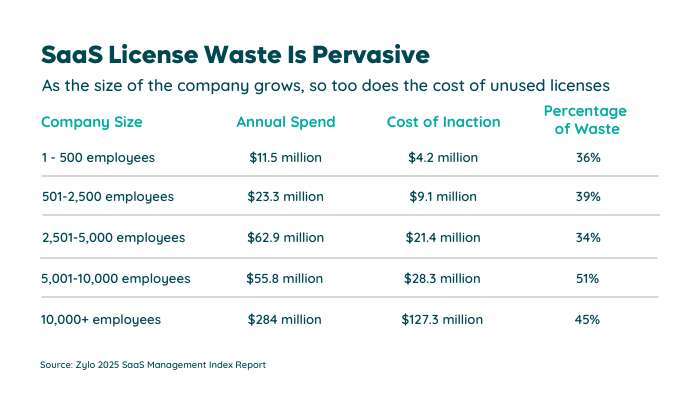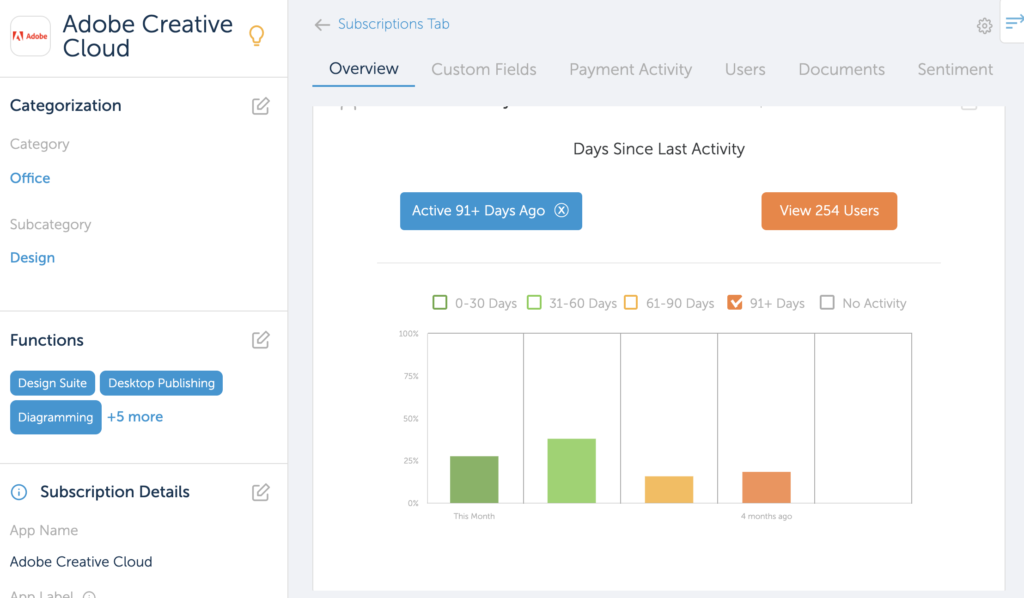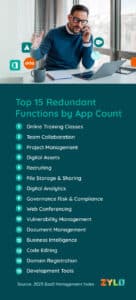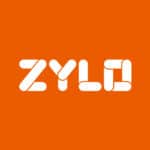Table of Contents
When the growth of SaaS applications goes unchecked and unmanaged, it invariably increases costs and risks in large organizations. However, when examined with a focus for optimization and license management, SaaS growth represents a cost-savings opportunity. Here’s how to optimize your SaaS stack and promote more effective utilization of applications, reduce unnecessary costs, and control risks.
After deploying SaaS management to hundreds of organizations, Zylo data shows that 53% of all SaaS licenses go unused in any given 30-day period. The average company spends more than $4,830 on SaaS applications for each employee each year, but 53% of that investment isn’t utilized.

That said, SaaS optimization represents an enormous opportunity to cut out unnecessary costs, especially for large organizations. If utilization could be fully optimized, a company could theoretically save more than $2,300 per employee per year.
Why SaaS Applications Are Over-Licensed and Underutilized
Shadow IT and the growing sprawl of available SaaS applications frequently obscure the fact that there’s a lack of utilization. It’s impossible to manage SaaS applications, subscriptions, or licenses if they have not been identified within the organization first. For many organizations, creating an inventory of all SaaS applications in use within the organization represents the first step towards optimization.
RELATED: 5 Dangers of Ignoring Shadow IT
The second problem large organizations face following the discovery or identification of the full SaaS inventory is compiling that information into an effective catalog or system of record.
A system of record is an essential component of any SaaS Management program because it creates a one-stop-shop for all application attributes, including utilization data. Without a centralized system to record, critical information on application cost, usage, ownership, and other details quickly becomes lost.
How to Optimize Your SaaS Stack, First Prioritize
To begin evaluating SaaS applications for increased optimization, it’s critical first to prioritize which applications will receive focus. Rather than trying to optimize all applications identified within the environment – an inefficient and time-consuming endeavor – prioritize applications in one of these three ways (which are not mutually exclusive):
By total investment or spend – Make a list of the top five to 10 most costly or highest total spend applications. This focus tends to yield the most significant total cost reduction.
By approaching renewal date – Focusing on applications with upcoming renewal dates or notification periods ensures that if the renewal occurs, its utilization can be addressed before the organization becomes locked into another subscription term.
By number of users – If an application is spread widely throughout the organization, such as office suite tools, video conferencing apps, or file-sharing tools, the likelihood of some users not fully using applications goes up.
Gather Spend Data
When thinking about how to optimize your SaaS stack, gather all relevant information about each application to be optimized. It’s important first to understand all current cost and spending information – otherwise, it will be challenging to ascertain savings or cost reductions created by optimization efforts.

A good source of truth for large-scale applications is the original purchase agreement or contract. Here, information regarding attributes such as license quantity, features, products, and planned spend outlined at the time of purchase can be found. Any documents outlining updates to the purchase agreement, such as the acquisition of additional licenses, features, or services, should also be sought out.
Another approach to determining baseline spending that can complement original purchase documents is identifying SaaS application dates within the organization’s financial transactions such as Accounts Payable line items, as well as expense reimbursement records and reseller agreements. This data can yield valuable information about who has purchased SaaS and how much the company is spending on SaaS overall.
Collect SaaS Utilization Data
Beyond documenting total spending, there are many other data points to gain a complete understanding of utilization.
Total users – Identify the total number of users for a given application. Keep in mind that in many organizations, multiple instances of the same application may exist.
User activity and log-ins– If the company uses a single sign-on platform, log-in information for multiple applications can be found quickly. However, it’s also important to identify log-ins occurring directly within the applications themselves. Creating a view that captures a range of log-ins over the last 30, 60, and 90 days can help determine which users are the most and least active for a given application.
Users provisioned with premium features or entitlements – One of the effective ways to cut costs during optimization is identifying users who are over-provisioned. Examine users with premium features carefully to ensure that their usage matches the additional expenses incurred.
Application-specific consumption metrics – SaaS applications often feature specific metrics that translate to additional costs. Examples include meeting minutes per user for video conferencing apps like Zoom, envelopes or packets for e-signature applications like DocuSign, or data storage thresholds for file sharing tools like Box. When a user or users surpass the allotted capacity, charges typically result.
Find Cost-Savings Wins
With an accurate view of utilization data most large organizations can quickly identify immediate cost-savings wins.
Users with little to no log-in activity
Reducing inactive users can quickly lead to cost savings. Look at user log-ins via the application’s management dashboard, single sign-on systems, or a SaaS management platform.

Identifying users with little to no log-in activity can help identify cost-savings opportunities produced by eliminating unused licenses. The Zylo SaaS management platform displays user activity and shows a comprehensive list of application users sorted by log-in date.
It’s essential to look at a range of log-in activity, typically comparing user log-ins across 30-, 60-, and 90-day periods, because some users may still require the applications, even if used infrequently. For users with very little or no log-in activity, reduce these licenses immediately if possible to create instant savings or reduce license counts before the next renewal.
Over-provisioned users
An additional immediate cost-savings win is to identify users who have been provisioned with premium application features, but whose usage only requires basic features. These users can be downgraded to basic license features, resulting in cost-savings for the organization.
Attritted users
Employee turnover can create ongoing costs for the organization – as well as security risks – if their SaaS application credentials are not turned off if and when they leave the organization. Compare HR records for attrited employees and compare that to the application’s user base. Unneeded licenses can be reprovisioned to other users or eliminated.
Build SaaS Management Processes to Optimize the Future
Following short-term cost savings actions for utilization, many organizations deploy SaaS management platforms or processes to address the challenges of SaaS growth going forward, determine how to optimize their SaaS stack, and for longer-term results.
Eliminate duplicated spend, redundant functionality

Another advantage to a SaaS Management platform or another system of record is the ability to identify unnecessary spending, such as when the organization procures an enterprise version of an application and employees acquire the consumer-grade version of the same application as shadow IT. With all spending and application information centralized and visible, this duplication can be highlighted and acted upon and lead to savings.
Similarly, organizations frequently find they have more than one tool for the same purpose. With an active SaaS Management program in place, it’s possible to consolidate these applications and standardize the organization on a chosen application, which can streamline spending and reduce intra-organizational friction due to competing toolsets.
Make new rules to prevent shadow IT
About one-third of all employees use credit card reimbursement to purchase SaaS applications. One strategy to prevent the recurrence of shadow IT is to introduce new policies, such as limiting employees’ ability to acquire software using expense reimbursement.
About one-sixth of all employees use credit card reimbursement to purchase SaaS applications.
Many organizations also create software review boards to review and approve any new proposed tool for financial, security, and regulatory compliance, as well as check the proposal against the current SaaS inventory to prevent duplicated spend or redundant applications.
Make the SaaS application inventory accessible to employees
Similar to a software review board, creating a catalog of all the SaaS applications maintained by the organization and available to new users can reduce duplicated spend and redundant functionality. A self-serve catalog carries the additional advantage of decreasing IT support ticket requests, as employees can request application access directly from the business unit, team, or employee responsible for its ownership.
Maintain a system of record
Using a SaaS Management platform to centralize data that provides visibility into utilization and other data is an outcome that many organizations strive for beyond simple usage optimization. Serving as a clearinghouse for information about users, usage, costs, security, compliance, and other factors create the ability to identify and optimize under-performing or costly applications quickly.
SaaS Will Continue to Grow, Manage SaaS Optimization Now
SaaS will continue to grow and displace traditional enterprise software. By building effective SaaS Management systems now – including mapping out the SaaS Management Lifecycle – organizations can optimize for savings and reduce risk. And a big piece of that is knowing how to optimize your SaaS stack.
ABOUT THE AUTHOR

Zylo
Zylo is the leading enterprise SaaS management platform that transforms how companies manage and optimize the vast and accelerating number of cloud-based applications organizations rely on today. The platform provides one system of record for all cloud-based software purchased across a company, enabling customers to discover, manage, measure and optimize cloud investments with real-time insights into spend, utilization and feedback data.

